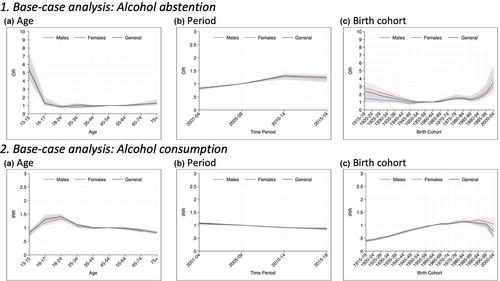Expanding our understanding of long-term trends in alcohol abstention and consumption in England (2001–19) using two age–period–cohort approaches
Abstract
Background and aims
Alcohol consumption has decreased in England in recent decades, while alcohol-specific death rates have remained relatively stable. Age–period–cohort (APC) models offer the potential for understanding these paradoxical trends. This study aimed to use an APC model approach to measure long-term trends in alcohol abstention and consumption in England from 2001 to 2019.
Design, setting and participants
The study used grouped and proxy-variable APC models of repeat cross-sectional survey data, set in England (2001–19). Participants were residents in England aged 13 years or over who took part in the Health Survey for England.
Measurements
Outcome variables were alcohol abstention and consumption in units. We created nine age groups (13–15, 16–17, 18–24, 25–34, until 65–74 and 75+, reference 45–54 years), four periods (2001–04, 2005–09, 2010–14 to 2015–19, reference 2005–09) and 18 5-year birth cohorts (1915–19 to 2000–04, reference 1960–64). We proxied age effects (systolic and diastolic blood pressure), period effects (alcohol affordability, internet usage and household alcohol expenditure) and birth cohort effects (prevalence of smoking and prevalence of overweight).
Findings
The odds of abstaining were considerably larger at young ages, 13–15 years [odds ratio (OR) = 5.38; 95% confidence interval (CI) = 4.50–6.43], were lowest during the first period, 2001–04 (OR = 0.83; 95% CI = 0.79–0.86) and had a U-shaped pattern by birth cohort. For units of alcohol, the incidence rate ratio (IRR) increased until age 18–24 years (IRR = 1.41, 95% CI = 1.34–1.48) and decreased afterwards, were highest during the first period, 2001–04 (IRR = 1.07; 95% CI = 1.05–1.08) and showed an inverted J-shape by birth cohort. Our proxy variable approach revealed that using blood pressure measures, alcohol affordability and prevalence of overweight as proxies resulted in APC effects that differed from our base-case model. However, internet usage, household expenditure on alcohol and smoking prevalence resulted in APC effects similar to our base-case model.
Conclusions
The discrepancy between decreasing alcohol consumption and increasing alcohol-related deaths observed in England from 2001 to 2019 may, in part, be explained by the halt in abstention trends since 2010 and a slight consumption decline since 2001.


 求助内容:
求助内容: 应助结果提醒方式:
应助结果提醒方式:


